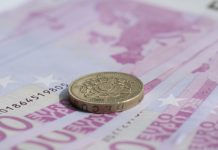A combination of pound weakness and dollar strength pushed the pound US dollar exchange rate lower on Thursday. The pair dropped from a peak of US$1.3217 to a low of US$1.3077. This is the weakest that the pound has traded at versus the dollar in 3 days.
| What do these figures mean? |
|---|
|
When measuring the value of a pair of currencies, one set equals 1 unit and the other shows the current equivalent. As the market moves, the amount will vary from minute to minute. For example, it could be written: 1 GBP = 1.28934 USD Here, £1 is equivalent to approximately $1.29. This specifically measures the pound’s worth against the dollar. If the US dollar amount increases in this pairing, it’s positive for the pound. Or, if you were looking at it the other way around: 1 USD = 0.77786 GBP In this example, $1 is equivalent to approximately £0.78. This measures the US dollar’s worth versus the British pound. If the sterling number gets larger, it’s good news for the dollar. |
Comments by Bank of England (BoE) Chief Economist Andy Haldane highlighted the issues that the BoE were experiencing in trying to assess the outlook for monetary policy going forwards. Mr Haldane remarked that the BoE could decide to raise interest rates or drop interest rates in the case of a disorderly Brexit. This would depend on how the economy reacts. The general assumption by economists is that an orderly Brexit will see the central bank hiking next year. That said, the uncertainty of the interest rate outlook from Haldane unnerved investors and sent the pound lower.
| Why do raised interest rates boost a currency’s value? |
|---|
| Interest rates are key to understanding exchange rate movements. Those who have large sums of money to invest want the highest return on their investments. Higher interest rate environments tend to offer higher yields. So, if the interest rate or at least the interest rate expectation of a country is relatively higher compared to another, then it attracts more foreign capital investment. Large corporations and investors need local currency to invest. More local currency used then boosts the demand of that currency, pushing the value higher. |
Today investors will be turning their attention back to the UK economic calendar. Analysts predict that UK GDP data will show economic growth of 1.3% year on year in the final reading for the second quarter. This is the same as the previous reading, so analysts are not expecting any changes. If the data shows a slight slowdown, the pound could sell off further.
| Why does poor economic data drag on a country’s currency? |
|---|
| Slowing economic indicators point to a slowing economy. Weak economies have weaker currencies because institutions look to reduce investments in countries where growth prospects are low and then transfer money to countries with higher growth prospects. These institutions sell out of their investment and the local currency, thus increasing supply of the currency and pushing down the money’s worth. So, when a country or region has poor economic news, the value of the currency tends to fall. |
Strong Data Lifts The Dollar
The mood for the dollar was positive in the previous session. Investors continued to digest the interest rate rise by the Federal Reserve and strong data also offered support to the greenback. US GDP showed that the US economy grew at the fastest pace in nearly 4 years. Whilst tis was an update on a previously released figure, it still showed the US economy was extremely strong. Durable goods orders were also exceptionally high at 4.8%, well ahead of the 2% forecast.
The strong data is further evidence to support the interest rate rise by the Fed on Wednesday. It also supports another hike in December. As a result, the dollar rallied higher.
Data will remain in focus today as inflation figures are released. Analysts are expecting US inflation to remain constant at the Fed’s 2% target. However, on a monthly basis, analysts see inflation ticking slightly lower. Lower inflation is not good for interest rates. This could slightly dampen demand for the dollar.
This publication is provided for general information purposes only and is not intended to cover every aspect of the topics with which it deals. It is not intended to amount to advice on which you should rely. You must obtain professional or specialist advice before taking, or refraining from, any action on the basis of the content in this publication. The information in this publication does not constitute legal, tax or other professional advice from TransferWise Inc., Currency Live or its affiliates. Prior results do not guarantee a similar outcome. We make no representations, warranties or guarantees, whether express or implied, that the content in the publication is accurate, complete or up to date. Consult our risk warning page for more details.
This article was initially published on TransferWise.com from the same author. The content at Currency Live is the sole opinion of the authors and in no way reflects the views of TransferWise Inc.





